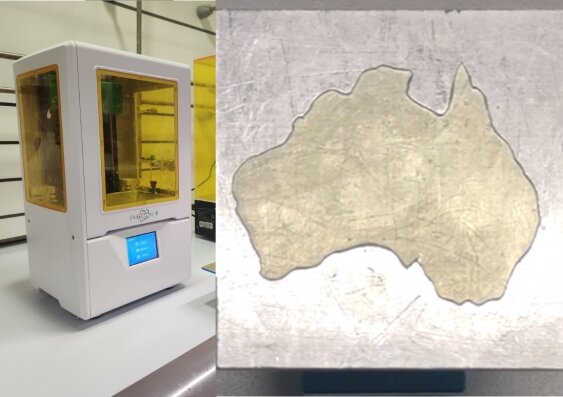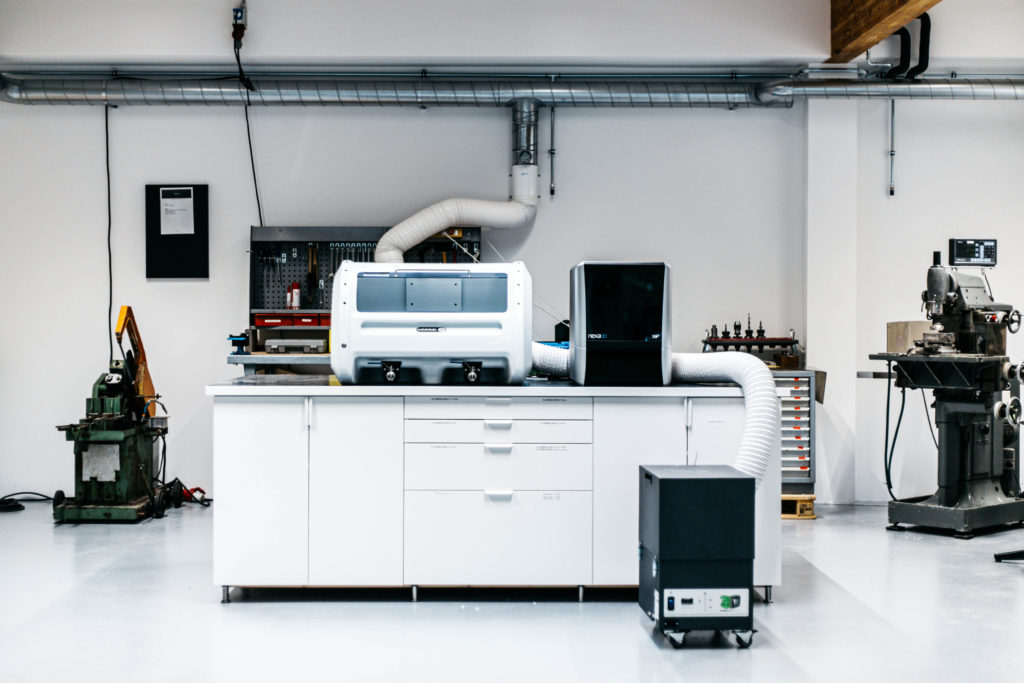We start with a metal AM sustainability report in today’s 3D Printing News Briefs, and then a new 3D printing process that offers novel energy storage design options. The Navy Price Fighters developed an AM cost and time model, and BOFA is partnering with Addifab for portable fume filtration technology. Finally, Ogle Motors created a one-third scale model of the Ariya concept car for Nissan.
Ampower Releases Report on Metal AM Sustainability
Industrial additive manufacturing consultancy Ampower has released a study on the “Sustainability of Metal Additive Manufacturing,” which analyzes the carbon footprint along the AM process chain. Industry, people, and politics have started to change their mindset about fossil fuel emission over the last five years, and many are working to reduce carbon emission and find more sustainable ways of living. AM has often been touted as a production technology that can reduce emissions and lower the carbon footprint of part production, but there haven’t been many detailed calculations regarding the complete production route of AM, as well as objective comparisons against traditional manufacturing. This report looks at when AM is more sustainable than conventional techniques, the significant influencing factors for a low carbon footprint, and how users can leverage the technology to reach their carbon goals.
“There is no general answer to which manufacturing technology has the lowest carbon footprint. The overall footprint is heavily influenced by the alloy group as well as the part geometry. Complex geometries with high buy-to-fly ratio are favorable for netshape technologies such as AM and casting, while simple parts might be most sustainable if milled. In the framework of this study, AMPOWER developed a Sustainability Calculator for the CO2 footprint. This tool enables the assessment of a variety of alloy and technology combinations as well as customization of the process routes.”
You can download the full report here.
UNSW 3D Printing Solid-State Polymer Electrolytes for Energy Storage
 Researchers at UNSW Sydney used a standard 3D printer to produce an intricate map of Australia made of solid polymer electrolyte, which was then tested as an energy storage device. Credit: Dr Nathaniel Corrigan
Researchers at UNSW Sydney used a standard 3D printer to produce an intricate map of Australia made of solid polymer electrolyte, which was then tested as an energy storage device. Credit: Dr Nathaniel CorriganA research team from the University of New South Wales (UNSW) developed a process for 3D printing solid-state polymer electrolytes, or SPEs, that can be used for novel energy storage designs. In a published paper, they explain that solid-state electrolytes are key in solid-state batteries, though they can have poor mechanical properties or low ionic conductivities, and that their high-performance 3D printed SPEs have robust strength and high conductivity. This means they could be used as the actual structure of a device, which opens up a wide range of design opportunities, specifically in future medical products that need small energy storage designs. In addition, the team used a low-cost, commercially available printer to fabricate its SPEs, made up of nano-scale ion-conducting channels embedded in a rigid crosslinked polymer matrix.
“With existing solid-state electrolytes when you increase the mechanical strength of the material, you sacrifice a lot of the conductivity. If you want higher conductivity the material is much less robust. What we have achieved is a simultaneous combination of both, which can be 3D printed into sophisticated geometries,” said Kenny Lee, a researcher with the university’s Cluster for Advanced Macromolecular Design (CAMD).
“This polymer electrolyte has the potential to be a load-bearing energy storage material. Because of its strength, it could be used as the actual structure of small electronics, or in aerospace applications, or in small personal medical devices given our 3D printing process can be very intricate and precise.”
AM Cost-Time Model Developed by Navy Price Fighters
 Engineman 1st Class Anier Carrillo checks the fitting of an additively manufactured valve aboard the USS Indianapolis (Courtesy Petty Officer 3rd Class Austin Collins)
Engineman 1st Class Anier Carrillo checks the fitting of an additively manufactured valve aboard the USS Indianapolis (Courtesy Petty Officer 3rd Class Austin Collins)In 2016, the Naval Supply Systems Command Weapon Systems Support (NAVSUP WSS) Navy Price Fighters (NPF) were asked to come up with a way to determine an AM business case for military applications, but realized there wasn’t a consistent way to do this. The NPF realized that to determine return on investment (ROI) for additive manufacturing, they would need to collect data to calculate both time and cost, and developed the Additive Manufacturing Cost and Time (AMCAT) decision tool. The web-based analytics tool is designed around standard engineering processes accomplished by DoD AM production sites across the U.S., and provides the necessary information to make an informed value decision. It standardizes the collection of AM data, enables metric reporting, and offers a comparison between AM and traditional supply chain solutions, and will continue to deliver more accurate results the more data it gathers.
“We needed to decide as a group what data we needed to collect in order to come up with additive manufacturing cost. The ultimate goal of the tool is to determine whether it’s more cost effective to use additive manufacturing or to use established supply systems,” explained William Peterson, NAVSUP WSS NPF Operations Research Analyst and AMCAT Team Lead.
“Our tool captures everything and uses real data for things like non-recurring engineering (labor hours and equipment purchases), shipping, contracting and transportation costs. The intention is to capture all of the costs of AM. Our tool is the only one capturing all that data.”
BOFA International & Addifab Partner for FIM Fume Filtration
Danish 3D printing company Addifab signed a contract with portable fume extraction and filtration leader BOFA International in the UK. BOFA will support Addifab’s unique Freeform Injection Molding (FIM) process with its portable 3D PrintPRO 4 fume filtration technology. Addifab’s three-step Print-Inject-Dissolve soluble mold solution allows manufacturers to very quickly create complex injection mold tooling from a variety of feedstocks, like silicones, composites, ceramics, thermoplastics, and metals. BOFA’s portable system uses advanced multi-stage gas filtration, including a large HEPA filter and deep carbon bed, and will support Addifab’s desktop demolding station in filtering emissions during the dissolve phase—an alkaline-water solution will release the injection molded part from the 3D printed tool once it reacts with dissolvable resins.
“At Addifab we are proud to be partnering with one of the leading innovators in the fume extraction field,” said Thore Langholz, Product Development Team Lead at Addifab. “This collaboration allows us to offer our Freeform Injection Molding process in a compact and portable package while keeping user safety as our highest priority. I am excited to see profound shifts in productyping and small-scale productions that this package will bring.”
Ogle Motors Makes 3D Printed Scale Model for Nissan
 Nissan Ariya Front
Nissan Ariya FrontFinally, Nissan’s futuristic Ariya single seater concept car, featuring a bespoke chassis, Formula E design, aerodynamic wheel covers, all-wheel drive, and the powertrain of the all-electric Ariya SUV, showed the motoring world what an electrified performance motor could really look like. The company liked the design so much that it wanted a one-third scale model of the vehicle to keep at the reception desk of its London-based UK Design Centre, and asked Ogle Models to take on the job. Including SLA 3D printing, CNC machining, and painting, the build took nearly 500 hours, and the material choice was governed by the complexity and weight of the parts. Once the parts were created, they were assembled with allowances for paint, and then the model was disassembled for painting and graphics application, before being reassembled and secured to a plinth.
“It was quite a complex project. Because the CAD model had only A surface data, we had to create the B surface which added thickness and features so something physical could be produced, ensuring that no undercuts were created, so the individual parts could all fit together like a jigsaw puzzle,” said Philip Martin, Ogle’s Director.
“We were extremely pleased with the finished model, which was made even more satisfying when we received such positive feedback from Nissan’s design centre.”
Subscribe to Our Email Newsletter
Stay up-to-date on all the latest news from the 3D printing industry and receive information and offers from third party vendors.
You May Also Like
3D Printing Financials: Fathom Struggles in Financial Quicksand During Critical Transition
Facing a year of key transitions and financial pressures, Fathom (Nasdaq: FTHM) has filed its annual report for 2023 with the U.S. Securities and Exchange Commission (SEC). The document outlines...
Latest Earnings Overview for Australian 3D Printing Firms Titomic and AML3D
Australian 3D printing manufacturing firms Titomic (ASX: TTT) and AML3D (ASX: AL3) reported their financial results for the period from July to December 2023, marking the first half of their...
3D Printing Webinar and Event Roundup: April 7, 2024
Webinars and events in the 3D printing industry are picking back up this week! Sea-Air-Space is coming to Maryland, and SAE International is sponsoring a 3D Systems webinar about 3D...
3D Printing Financials: Unpacking Farsoon and BLT’s 2023 Performance
In the Chinese 3D printing industry, two companies, Farsoon (SHA: 688433) and Bright Laser Technologies, or BLT (SHA: 688333), have recently unveiled their full-year earnings for 2023. Farsoon reported increases...

































